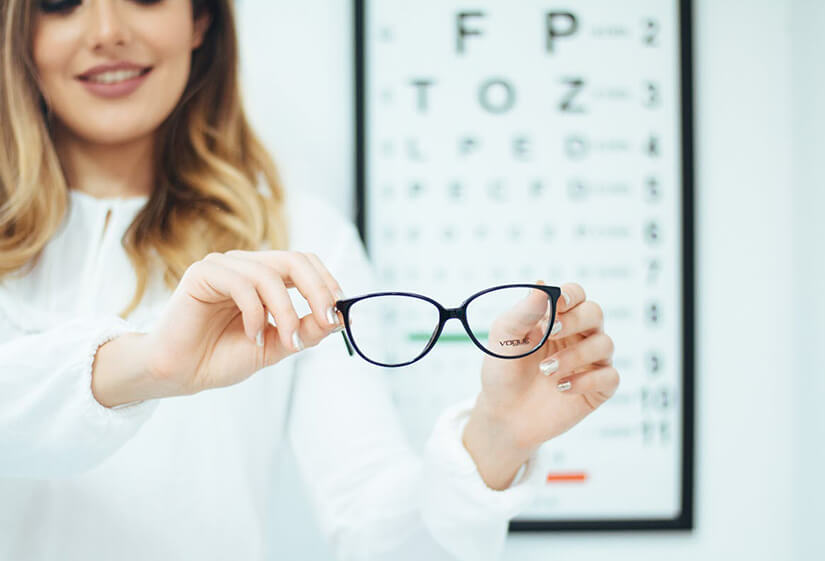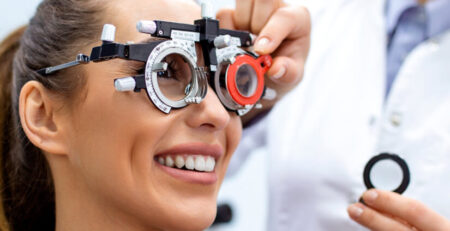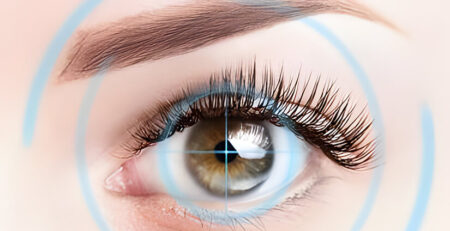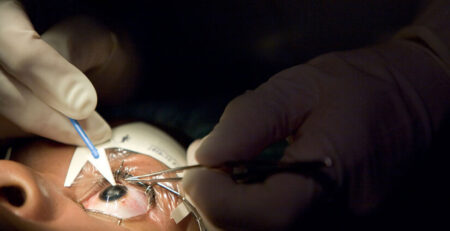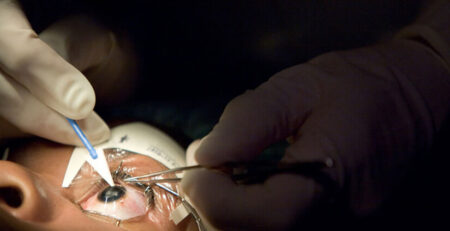Types of Refractive Errors And How They Are Corrected
Imagine a world where everything is blurred or distorted, where you struggle to read a sign or recognise a familiar face. That’s the reality for millions with refractive errors, common eye conditions that affect how light is focused onto the retina.
But fear not! With modern advancements in eye care, there are various ways to correct these pesky vision problems and restore crystal-clear vision.
From nearsightedness to farsightedness, astigmatism to presbyopia, we will take you on a journey to understand the different types of refractive errors and refractive error correction methods.
What Are Refractive Errors?
Refractive errors are common eye conditions that affect how light is focused onto the retina, leading to blurry or distorted vision. The eye can refract or bend light to focus it onto the retina, which is responsible for transmitting visual signals to the brain. However, when the size and shape of the eye or its components, such as the cornea or lens, is not ideal, it can result in refractive errors.
There are several types of refractive errors, including myopia (nearsightedness), hyperopia (farsightedness), astigmatism, and presbyopia. Refractive errors can impact people of all ages and significantly affect daily activities such as reading, driving, and using electronic devices.
However, the good news is that several refractive error correction methods, including glasses, contact lenses, surgery, or other specialised treatments, allow individuals to achieve the clear and crisp vision.
Refractive Errors Types
Refractive errors are common eye conditions that affect how light is focused onto the retina, resulting in blurry or distorted vision. There are several refractive errors types, including:
1- Nearsightedness (Myopia)
Nearsightedness, also known as myopia, is a common refractive error type affecting the ability to see distant objects clearly. In myopia, the eyeball is too long from front to back, causing light to focus in front of the retina instead of directly on it. As a result, distant objects appear blurry or out of focus, while close objects may still be seen clearly.
Myopia often develops during childhood and worsens during adolescence, although it can also develop in adulthood. It can be caused by genetic and environmental factors, such as excessive near work (reading or using electronic devices for extended periods) and lack of outdoor activities.
Symptoms of myopia may include squinting, eye strain, headaches, and difficulty seeing distant objects, such as road signs or the board in a classroom. The doctor may prescribe eyeglasses with a specific lens for this refractive error correction.
2- Farsightedness (Hyperopia)
Farsightedness, also known as hyperopia, is another common refractive error that affects the ability to see near objects clearly. In hyperopia, the eye is too short, or the cornea is too flat, causing light to focus behind the retina instead of directly on it. As a result, near objects may appear blurry or out of focus, while distant objects may still be seen relatively clearer.
Hyperopia can be present from birth or develop later in life, and a combination of genetic and environmental factors can cause it. Some individuals with mild hyperopia may not experience symptoms, while others may experience eye strain, difficulty with close-up tasks, such as reading or using digital devices, and headaches. Glasses or contact lenses are prescribed for this refractive error correction.
3- Astigmatism
Astigmatism is a common type of refractive error that is caused by the irregular or oblong curvature of the cornea or the eye’s lens, resulting in an irregular shape. Instead of being perfectly round like a basketball, the cornea or lens may be shaped more like a football, causing light to focus on multiple points rather than a single point on the retina. As a result, both distant and near objects may appear distorted or blurred, and vision may be overall blurry or hazy.
Astigmatism can be present from birth or develop later in life, and it can occur in combination with nearsightedness, farsightedness, or on its own. Genetic factors, eye trauma, or other underlying eye conditions can cause it.
Symptoms of this refractive error type may include blurry or distorted vision, difficulty with night vision, eyestrain, headaches, and squinting.
4- Presbyopia
Presbyopia is a common age-related condition that affects the eye’s ability to focus on near objects due to a loss of flexibility in the lens. It typically occurs after the age of 40 and gradually progresses over time.
As the lens in the eye loses its elasticity, it becomes less able to change shape and adjust its focus from distance to near vision. This results in difficulty seeing close-up objects, such as reading, using a smartphone, or threading a needle, while distant objects may still be seen relatively clearly.
Symptoms of presbyopia can include blurred near vision, eye strain, headaches, and the need to hold reading materials at arm’s length to see them clearly. Presbyopia affects everyone to some degree as they age, regardless of their previous vision status.
An eye specialist in Delhi will perform a comprehensive eye exam to determine the type of refractive error.
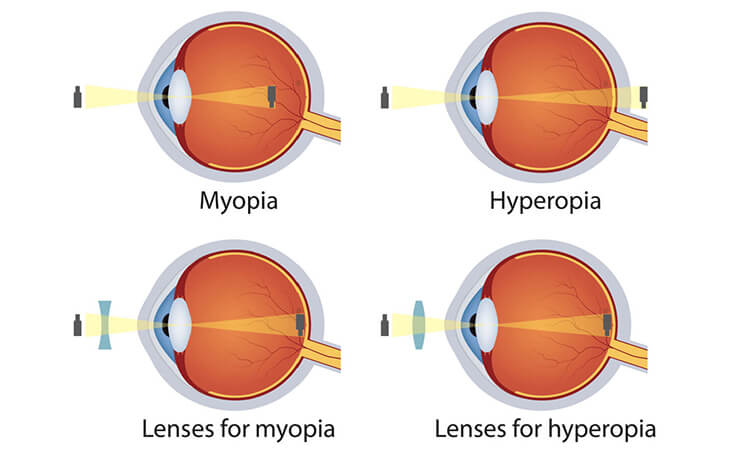
How to Correct Refractive Errors?
There are several methods for refractive error correction, depending on the type and severity of the error. Here are some common approaches:
1- Glasses
Eyeglasses with the appropriate lenses (concave, convex, cylindrical, bifocal, multifocal) are popular and effective for correcting refractive errors. Glasses with specific optical powers compensate for the abnormal shape of the eye, allowing light to focus properly onto the retina. Glasses can correct nearsightedness, farsightedness, astigmatism, and presbyopia. They are available in various styles and designs to suit individual preferences.
2- Contact Lenses
Contact lenses are thin, curved lenses placed directly on the eye’s surface to correct refractive errors. They can provide a more natural and unobstructed field of vision than glasses. They are available in different types: soft lenses, rigid gas permeable lenses, toric lenses for astigmatism, and multifocal lenses for presbyopia.
3- Refractive Surgery
Sometimes an eye specialist in Delhi can prescribe refractive surgery to correct the refractive errors. Refractive surgery is a permanent solution to correct refractive errors by reshaping the cornea, the eye’s clear front surface. There are several types of refractive surgeries, including LASIK (Laser-Assisted In Situ Keratomileusis), PRK (Photorefractive Keratectomy), SMILE (Small Incision Lenticule Extraction), and others. These surgeries use laser or other surgical techniques to precisely reshape the cornea, allowing light to focus properly onto the retina.
For patients unfit for corneal surgeries, refractive error is corrected by ICL, IPCL, clear lens extraction and refractive lens exchange.
These surgeries work by by either putting a lens inside the eye or replacing the natural lens of the eye with an artificial lens.
The most suitable method of correcting refractive errors depends on various factors, such as the type and severity of the refractive error, the overall health of the eyes, lifestyle and visual needs, and personal preferences. A comprehensive eye examination by an eye specialist in Delhi is essential to determine the most appropriate treatment option for an individual’s needs.
Wrapping Up!
Refractive errors such as nearsightedness, farsightedness, astigmatism, and presbyopia are common eye conditions that can affect the clarity of vision. However, with advancements in eye care, various methods exist to correct these refractive errors and improve vision.
Various refractive error correction options are available to suit different needs and lifestyles, from prescription glasses to contact lenses to refractive surgery. Seeking professional advice from an experienced eye care specialist is essential to determine the most appropriate treatment for your refractive error.
So, if you are experiencing blurry vision, difficulty seeing objects at a distance or up close, or other vision issues, don’t hesitate to schedule a consultation with Dr Anisha Gupta, a trusted eye care professional. Take the first step towards clearer vision and better eye health!

